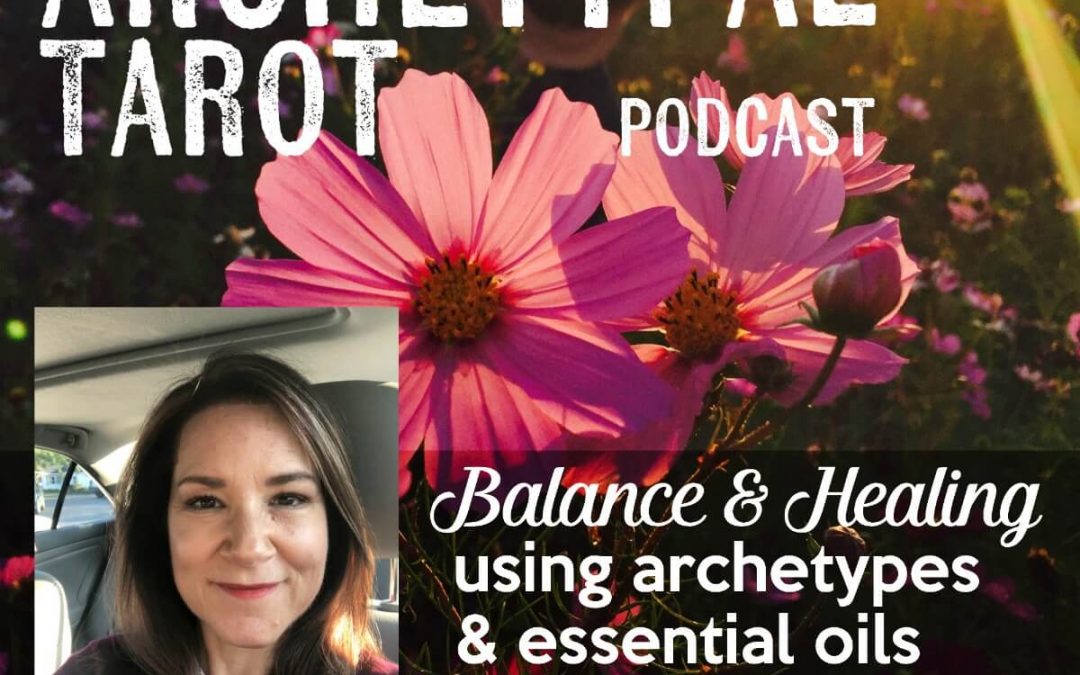
by Julienne Givot | Aug 14, 2018 | All Articles, Guest Contributors, Podcast Interviews, Podcasts |
 Podcast available on Apple Podcast, iTunes and pretty much wherever you download your podcasts.
Podcast available on Apple Podcast, iTunes and pretty much wherever you download your podcasts.
Published: August 12, 2018
Aloha! We have been on a bit of a summer sabbatical but we are back and excited to get this episode out to you! As ever we invite you to be part of making the podcast magic happen by joining our Patron team! Just visit tiny.cc/tarot for more information.
This episode features a conversation with Barb Kurkas Lee. Barb is a certified clinical aromatherapist and archetypal consultant. Her service is to partner with people to help them nurture and connect to their inner lives. Check out her very cool blog and info on her service at barbkl.com.
We discuss her work which combines archetypal discovery with essentail oils to help balance and heal. Our conversation ranges to various archetypes such as the Victim, the Mother, the Alchemist, Healer and more. Toward the end of the show Julienne and Barb celebrate practices which feed the soul and encourage listeners to discover and keep doing the things that feed their soul even if they seem silly – all the better!
More on Barb Kurkas Lee:
Barb creates specific essential oil blends to support people as they connect to their soul’s compass. By learning our soul’s contract in working the archetypes, we find inner sustenance and peace. The interior work for a person is a labor of love. Barb’s education as a masters prepared nurse, retired nurse midwife, experience in other areas of healthcare, and hospice bring a deep dimensional witnessing of a soul’s journey on earth. Her ability to assist people and groups in their own labor of love is one of her callings.
Visit her website: https://barbkl.com/
Connect with her on Facebook: https://www.facebook.com/barbkl/
Connect with the Archetypal Tarot Podcast
https://twitter.com/TarotPodcast
https://www.facebook.com/ATpodcast
https://www.instagram.com/tarotpodcast/

by Julienne Givot | Jun 14, 2018 | Most Recent Podcasts, Podcast Interviews, Podcasts |
Part 1 is a conversation Julienne had with Archetypal Astrologer Shawn Nygaard. Shawn is an astrologer based in Minneapolis. He is a Tutor for MISPA (Mercury Internet School for Psychological Astrology), and has presented at conferences and different astrology schools as well as at The Minnesota Jung Association. His writing has been published in The Mountain Astrologer. Shawn is also a graduate of the CMED Institute in Chicago, where he studied archetypes and symbolism with Caroline Myss.
Their wide ranging conversation reflects on The Star card of the Tarot as our lens for looking at 2018, some of the major astrological aspects just ending and those for the near future. And of course, movies, music and culture.
Topics discussed:
- Moana
- Black Panther
- Super Heroes
- Pricilla Queen of the Desert
You can find out more about Shawn at his website
ImagineAstrology.com Follow us on Instagram, Facebook and Twitter and look for the Giveaway post where you could win a recording of A Brief Introduction to Archetypal Astrology by Shawn Nygaard.
Part 2 of Julienne’s conversation with Archetypal Astrologer Shawn Nygaard. Their conversation focuses on the archetypal symbolism and history the upcoming Saturn in Capricorn in 2020.
Find more info on Shawn on his website: https://www.imagineastrology.com/
Saturn in Capricorn – echoes of the slave trade
“There is nothing more satisfying, more gratifying than true adulthood.” – Toni Morrison
Subtopics include:
- Thresholds
- Capricorn
- The Handmaids Tale
- Black Panther
- Ancient Babylonia
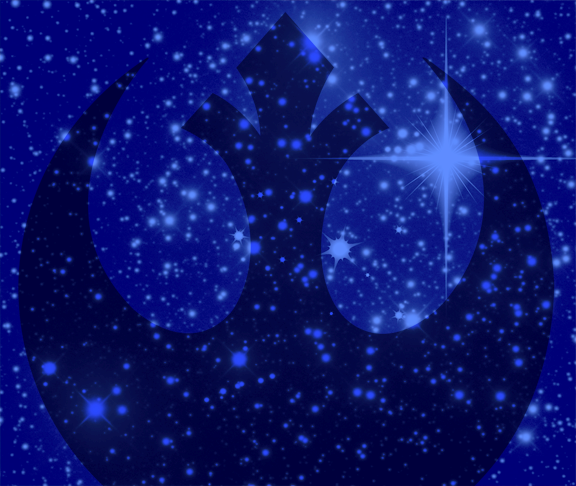
by Julienne Givot | Jan 18, 2018 | Most Recent Podcasts, Podcasts |
The first episode of 2018 has Cyndera and Julienne discussing the archetypes and mythological themes in the latest Star Wars film, The Last Jedi and the parallels to current events. Archetypes include The Priestess, The Hero, The Hermit, The Empress, The Chariot and the subverting of the Princess archetype. *SPOILER ALERT* If you haven’t seen the film yet we go deep into the film so spoilers abound.
They also pull a card to reflect on 2017 and one to work with for the year to come. The results might surprise you.
This is how we win. Not by fighting what we hate, but by saving what we love.
– Rose Tico as played by Kelly Marie Tran in The Last Jedi
Find out more about becoming a Patron of the Archetypal Tarot Podcast by clicking here Tiny.cc/tarot
Connect with the podcast team on Facebook , Twitter and Instagram or email tarotpodcast@gmail.com
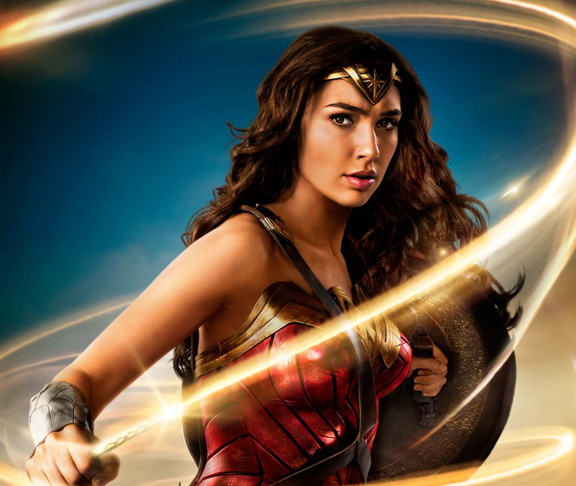
by Julienne Givot | Jul 17, 2017 | Faves, Podcasts, Pop Culture Archetypes |
Cyndera and Julienne bring their provocative archetypal and tarotic insights into the new film Wonder Woman. The archetypes in The Priestess, The Sun and the Chariot are at play in the film. They also discuss how listeners can become a part of the Archetypal Tarot team by signing up to be a patron of the show. https://patron.podbean.com/atpodcast
Treatise on Wonder Woman by Cyndera Quakenbush
In an attempt to add a poster of Wonder Woman to my office, a new colleague of mine expressed her reservation to the addition of this image to the office environment, which, to her credit, did contain a speech bubble from Wonder Woman’s mouth saying “No Time for Naughty.”
She articulated: “I feel it’s important to celebrate real women, brave and courageous historical leaders who had an actual impact on the world.”
I felt as though wounded, as if a spear had gone straight through my heart, as if she was saying I
wasn’t real. Why on earth did I feel this way? Wonder Woman is not, in fact, flesh and blood, and I am certainly myself not Wonder Woman.
The poster did indeed stick out like a sore thumb on the wall, she did not match the drab green walls, the muted tones of the overhead file bins. Would my own personality clash as brilliantly as this to the work culture? Wonder Woman seemed protected in her plastic cover, the natural light causing her to emit an armor of reflected light. I was speechless, tears came to my eyes, I left early from my first official day, along with the poster.
Today, in Wonder Woman’s defense, these words have come me:
You speak of the courage of suffragettes, the immensity of emotion portrayed in Frida Kahlo’s artwork, but who would these women be without the forces that came alive within them. We speak of these forces in abstracted terms all the time – they are real and present even after each historical woman exhales her last breath – Courage, Leadership, Imagination, Vision. Fictional figures such as Wonder Woman, illustrate and actually embody these forces for us.
The gift of Fiction, the gift of art, that percolates through our culture in various guises – depicts for us these forces we hope to ourselves enact. We can celebrate the lives of historical women AND embrace the inspiration of of the figures of fiction – who try on possibilities, dreams and visions that our not-so-humble humanity has not yet dared.
Scientists look to science fiction for ideas of invention and innovation. Teachers and psychologists look to literature for an understanding of human behavior. Mathematicians have found formulas from their dreams (another source some may call “not real”)
“The Gods have not died, they have just gone underground.”
The forces within us are Real – Love, Hate, Courage, Passion, Intelligence. Allow us to celebrate and be educated by history and Imagination alike, for one teaches of the past the other of the future.
Since her creation, Wonder Woman has been resurrected many times, always reflecting the struggles of the age. Her tiara and dark tendrils rise again, along with a voice that is once again trying to be heard.
What do you believe in? What do you wish to stand for?
Do you act from Love or do you simply hide and take cover from fear?
Wonder Woman’s name is Diana Prince – Diana connects her to the name of the Roman Goddess of the Moon. Like the light of the Moon, her power is a reflected one and thus reminds us of REFLECTION – the power to look within yourself to see your own shadows and your own light. Prince – though she is a woman she also embodies the sacred masculine. She is in touch with her noble male capacities (the animus in psychology). And thus Diana Prince, Wonder Woman, is a marriage of opposites, the holding of a tension between differences, and thus a medicine for our deeply divided times.
Red, White and Blue are the colors of Wonder Woman’s classic costume. In one comic, she is actually dressed from a tattered American flag. Since WWII Wonder Woman has stood for what is noble about the United States, a symbol of liberty, justice and truth. She rises in the face of what is most ugly about our country, which has always been equipped with the teeth of greed, bigotry, narcissism and blindness.
Wonder Woman rises with only the weapons of truth, and her own strength to remind us of the hope we must not lose hold of. Hold tight to the Lassos of Truth! Feel the bondage of those bracelets encircling your wrists, reminding all deeds done by these hands to be for the liberation of self and others.
Feel the tiara, placed upon the crown of the head, framing the third eye of Insight, Intuition and crystallized concentration. Most of all, feel your heart, beating with life, beating with love for life bursting in each moment with your passion…
Sign up to be a part of the Archetypal Tarot Patron Team! tiny.cc/tarot
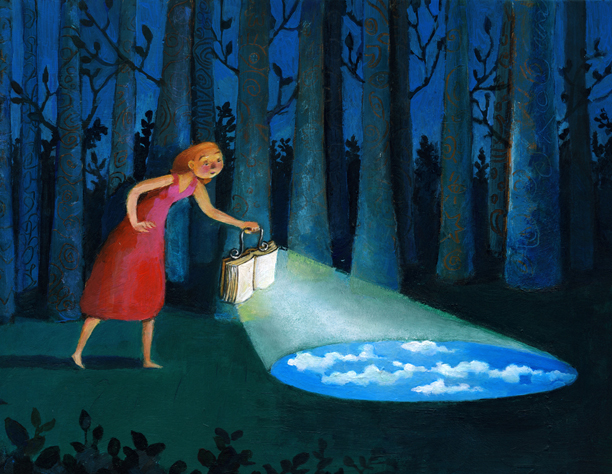
by Julienne Givot | Oct 15, 2014 | All Articles, In search of wisdom blog, Real Life Archetypes |
I nto each life comes information that changes the course of your life, in tiny ways and gargantuan ones. For me, books have always been a source of life-changing information. Fiction and non-fiction alike have turned the rudder of my life for as far back as I can remember. There are some that I sought out, heard about from a friend or teacher and others that literally have leaped off the shelf and fallen at my feet.
nto each life comes information that changes the course of your life, in tiny ways and gargantuan ones. For me, books have always been a source of life-changing information. Fiction and non-fiction alike have turned the rudder of my life for as far back as I can remember. There are some that I sought out, heard about from a friend or teacher and others that literally have leaped off the shelf and fallen at my feet.
If you have a curiosity about meaning, creativity, relationships, connection, philosophy and just what the heck our purpose for being here is, you will get a great deal from these books too.
Of the very, very long list I could create, these are 10 of the most influential in my own life. I have read them all again and again, always gleaning new and delightful truth from them and often at just the right time.
There would be no point in trying to rank them in order of importance or impact but I’ve listed them in the order that I read them for the first time, going back over 20 years.
Over the coming months I will post my thoughts about many of these and invite you into discussion. Their wisdom is evergreen, their ability to bring light and truth as strong today as when they were published.
The 10 Books That Saved My Live (metaphorically anyway!)
Man’s Search for Meaning by Viktor Frankl
The Artist’s Way by Julia Cameron
The Theory of Everything by Ken Wilber
Sacred Contracts by Caroline Myss
How Can I Help? by Ram Dass & Paul Gorman
The Soul’s Code by James Hillman
We: Understanding the Psychology of Romantic Love by Robert A. Johnson
The Three Marriages: Reimagining Work, Self & Relationship by David Whyte
Callings: Finding and Following an Authentic Life by Gregg Levoy
Tattoos on the Heart: The Power of Boundless Compassion by Greg Boyle
If you have a book club and are looking for new exploratory books to read, I highly recommend every single one of these.
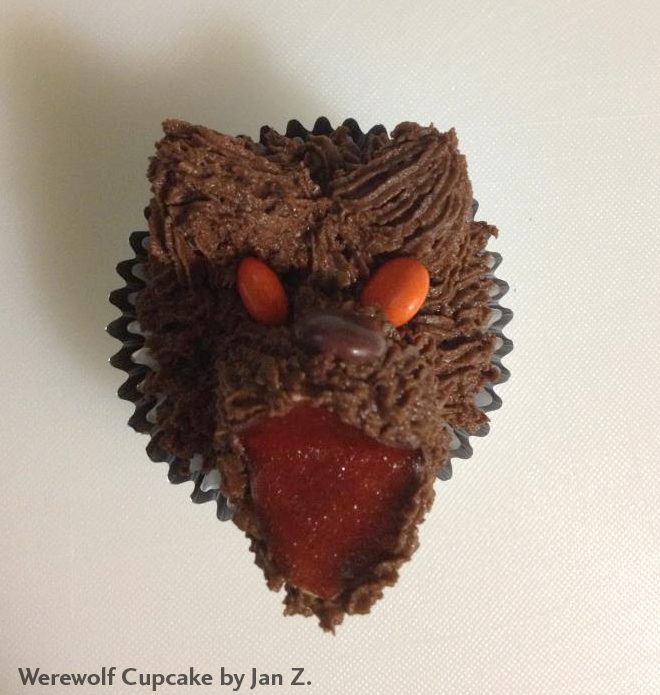
by Julienne Givot | Oct 26, 2012 | All Articles, In search of wisdom blog |

Awesome werewolf cupcake made by my friend Jan.
Halloween is such a great archetypal holiday. What other time do people get to dress up and show their alterna-selves? When my clients are trying to figure which of two similar archetypes fits them the best, I often suggest they try each one on and see how they fit. This is metaphorical but it’s also something one can do more literally by donning a costume. It can also be fun to try on something that is radically different from what you think is the norm for yourself and see how it goes. Halloween is all about this and we have the benefit of stores filled with costume ideas and accessories.
So what will your costume be this year? Does it represent an aspect of who you are or are you trying something different? Costumes can be a great way to explore and express ourselves. Whether you are going in for the whole Halloween costume thing this year (or any other time) try this experiment for some learning fun.
Archetypal Halloween Experiment
1) Visit my Discover Yours page and click the quality that you least identify with. What sort of costumes could you come up with based on the archetypes listed? What sorts of characters have those archetypes? Would you have fun trying on some of those outfits and seeing what would happen?
Next
2) Back on the Discover Yours page click the one quality that you think is the most ‘you’ of all of them. Click to open the box and see what archetypes are there. Could you imagine dressing up in a costume based on one of those listed? What sorts of characters have those archetypes?
Result: My guess is that you have probably dressed up (or thought of dressing up) in probably one from each 1 and 2. Why? We are drawn to what we have an affinity for as well as our opposites. Or I should say perceived opposites.
Carl Jung postulated that all archetypes reside within the collective unconscious and are accessible to everyone. In my practice I use about 12 archetypes with my clients which represent the core patterns they work with throughout their lives. Can we work with more than 12? The answer is yes! I believe along with many other archetypal teachers and researchers that we do work with many, many patterns but some are like situational one offs. For example someone who has the Peacemaker archetype can at times have a need to be a Warrior if circumstances call for it in a situation like defending a loved one. The Warrior might not be a usual archetype the person works with, but it can arise from time to time. Most people have done or said something and wondered “where did that come from?” which I would say is probably a shadow archetype popping up based on the situation. Jung also wrote about the archetype of the Shadow which in essence is the unseen or unacknowledged part of us. The Shadow could contain all sorts of archetypal characters and if you did the experiment above you might have found that one or two cropped up. Many times Shadow is referred to as being bad, but I try not to do that because making a hard judgement about something tends to shut down the learning process.
Have questions or want to post your results? Want some ideas for costumes to go with archetypes? Leave a reply below or shoot me a message!
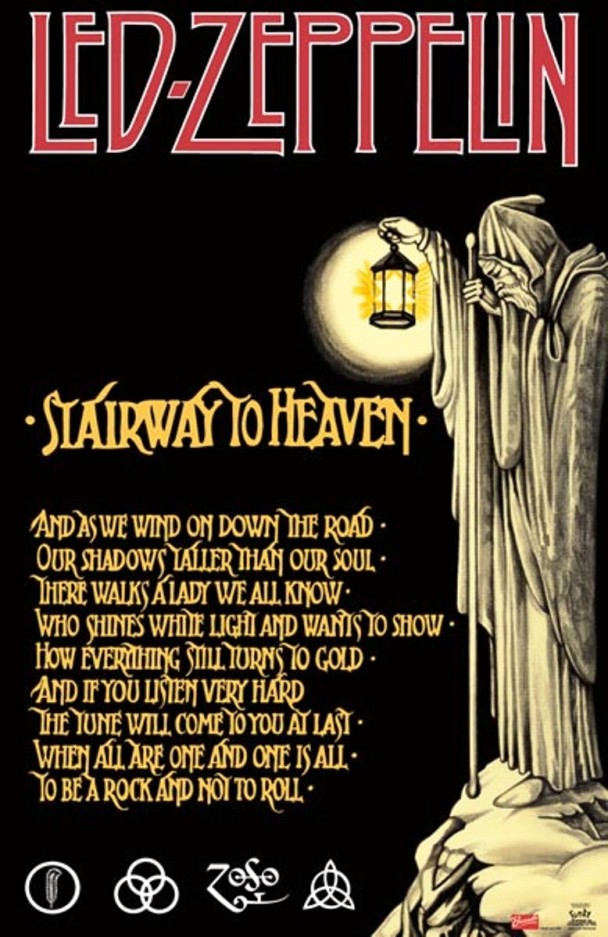
by Julienne Givot | May 21, 2012 | Major Arcana Heros Journey, Podcasts, Pop Culture Archetypes |
The Tenth edition of the Archetypal Podcast takes us to meet The Hermit, a figure waiting off the beaten track with the wisdom

that only remote regions can give. Card number 9 allows our hero traveling through the Major Arcana to either meet or become this humbled figure full of in-sight, as represented by his seeking lantern. A re-evaluation of his journey is required after a run-in with the objectivity of Justice, before he can once again chance the Wheel of Fortune (Card number 10). Consideration of this card allows us all a moment to reflect without being sucked into eternal isolation – the shadow side of the Hermit. Fresh from a (hot) visit from her hometown of Joshua Tree, California, Cyndera shares fresh inspiration after encountering an old friend who embodies the Hermit archetype. Julienne takes us on a tour of the hermitic nature of the American literary Renaissance along with some insights on the Hermit from film and popular culture.
Light Aspect: Integration, Introspection
Shadow Aspect: Isolation
Examples of the Hermit:
Henry David Thoreau (esp his book Walden) there is a great podcast about Thoreau from the public radio program ‘To The Best of Our Knowledge’.
Buddhist teacher, Pema Chodron, author and Catholic mystic Thomas Merton, poet Emily Dickinson, naturalist John Muir Also of interest is the Hermitary website filled with even more insight on the Hermit archetype.
 I also found it amusingly appropriate that Led Zeppelin used the image of the Hermit for their single ‘Stairway To Heaven’ which carries lyrics capturing the ideas of the Hermit’s quest.
I also found it amusingly appropriate that Led Zeppelin used the image of the Hermit for their single ‘Stairway To Heaven’ which carries lyrics capturing the ideas of the Hermit’s quest.
In film:
Robert Duvall in Get Low (2009)
Emile Hirsh in Into the Wild (2007)
Bill Murray in Lost in Translation (2003)
Forest Whittaker in Ghost Dog (1999) (Combination of Hermit and Warrior)
Key Words:
• Introspection —– Silence —– Guidance —– Reflection
• Solitude —– Looking inward —– Reclusion —– Being quiet
• Inner search —– Deep understanding —– Isolation
• Distance —– Retreat —– Philosophical attitude
Like what you heard on the podcast? Share us on Facebook (handy button below) or give us a review on iTunes.
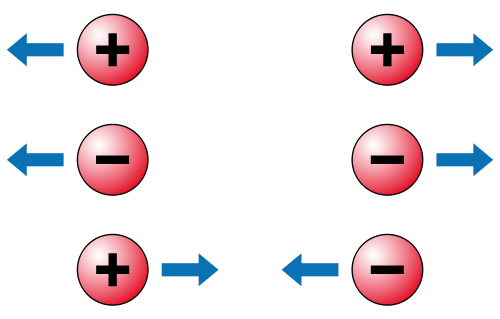
by Julienne Givot | Jun 15, 2011 | All Articles, Archetypes and Dating |
We are attracted to people by archetypal patterns. For most people it can be so subtle that you don’t know what’s going on, but paying attention to these powerful patterns can really improve your dating experience. I mean, wouldn’t you want something to help guide you through the sometimes dark and murky forest of dating life and toward what you are really looking for?
what’s going on, but paying attention to these powerful patterns can really improve your dating experience. I mean, wouldn’t you want something to help guide you through the sometimes dark and murky forest of dating life and toward what you are really looking for?
No need to take tests, get astrological information, blood type or genealogy, just pay attention, suss out the patterns and go from there. In this series I’m going to break archetypal attraction down to some usable basics. The key to all of this is to pay attention in a new way – one that is a bit less emotionally cloudy. You needn’t be a detective, but someone who can see, listen and be present to what is going on with yourself and the people you are meeting.
There are two basic ways to look at archetype attraction, Romantic Archetypal Chemistry and Shared Archetypal Chemistry. We are repelled by certain archetypes too but I’ll cover that in another post.
Archetypes are short hand for an indelible collection of behaviors, personality traits and most importantly motivations. They have a light side and a dark side. Unless you are living on another planet, you can bet that it’s only the happy shiny version of the archetype that’s showing up for dates for the first few months.
“When you date…have you ever noticed when you meet somebody for the first time, you’re not meeting them. You’re meeting their “representative”. Then after a about 3 months you meet the REAL Candidate” ~Chris Rock
Knowing the archetypal makeup of yourself (both the shiny and the dark) and the one(s) you are dating is a good way to have an idea of what the potential is for the relationship as well as steer clear of some unwanted dating mismatches. How do you do this? Well naturally working with someone like myself will give you that edge but I’m hoping that these articles will have you beginning to use these ideas.
To get you started – think about the relationship you are looking for – what archetypes do you want that person to have? What attracts you to those archetypes in another person? Use the archetype list here as a reference.
Archetype attraction part 2: Romantic Chemistry
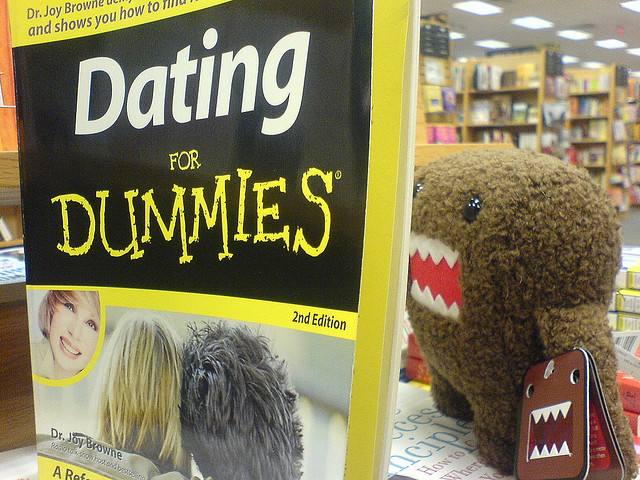
by Julienne Givot | Jun 2, 2011 | All Articles, Archetypes and Dating |

Not an endorsement of the book, but a funny picture. Photo©Isaach Hsieh
I was at a gathering recently and mentioned that I was thinking of writing about archetypes and dating. Heads swiveled, glasses stopped clinking and I had the feeling that I was in some sort of TV commercial with all eyes on me. Everyone wanted to know more and where they could go to read up on my insights. The response, beyond being kinda funny, has been pretty much the same for everyone I’ve floated the idea out to. It’s a fascinating topic and with that kind of response, how could refuse?
Do archetypes play a part in dating? Oh indeed they do! In fact dating might be one of those activities that bring out some patterns that you might not have thought much about before or just took to be typical dating neurosis.
For some, dating is a joy, to others it’s a chore or even akin to a trip to the dentist. For those of you in the latter camps, here’s some good news, there is a different way to look at dating beyond the love it/hate it quotient. One that is as multi-contextual and fascinating as life itself and yet totally practical. Archetypes might be one of the best ways to get clear on who you are and what you want before you pick up the phone, go out to the bars, start that online profile or flirt with the girl/guy in line with you at Trader Joes.
So friends, fellow singles and interested parties I’m going to put what I know about archetypes and dating out there and include some of the things I’ve learned from other sources into this new series of posts. My style will be a bit more casual, and a bit more comical. Posts will always have the comment section open for questions and feedback. You could even start now by adding your own 2 cents worth, request or question.
Here is a list of all of the Archetypes and Dating posts
Yours Truly,
Julienne

by Julienne Givot | May 25, 2011 | All Articles, Archetypal Characters, In search of wisdom blog, Real Life Archetypes |
Are you the hub that connects a diverse group of people? If someone mentions they are looking for a new job or a place to have great Korean Barbecue do you have a list of suggestions for them? Do you make it a habit of never throwing out business cards or deleting numbers out of your phone, just in case you want to contact them or share their info with someone else (not counting ex-boyfriends/girlfriends). These are all traits of the Networker archetype.
 We are in an age of connectivity and it doesn’t appear that we can ever really go back to a time of slow paced communications. It’s as if technology is making Networkers of all of us to one degree or another.
We are in an age of connectivity and it doesn’t appear that we can ever really go back to a time of slow paced communications. It’s as if technology is making Networkers of all of us to one degree or another.
I had a chance to observe how people socialize in a Networker environment during last week’s Small Business Week in San Francisco. I could see people with a natural penchant for the Networker chatting up one person after another, exchanging business cards and moving on to the next. Others seemed a bit more reticent to walk up to a stranger and introduce themselves. If you fall into the latter category, here’s good news – you needn’t have the Networker archetype to make new connections, you just need to pay attention and find someone who is. The next step might be the most difficult for the shy, but will pay off with a deep breath and a “Hello, my name is. . .” to a Networker. If they are worth their salt in networking they will be glad to meet you and introduce you to more people with little prompting. Often times it’s as simple as staying in their orbit and letting them do what they do best. These are the social butterflies with the smart phone filled with contacts and are often the key to finding the people, resources and excellent gelato that you have been looking for.
Malcolm Gladwell’s book The Tipping Point: How Little Things Can Make a Big Difference is an ode to the power of this particular archetype. Imagine how many times in your life you have met just the right person or found just the right thing because you made one little contact. Gladwell goes even further to show us just how incredibly powerful the archetype of the Networker is to spread ideas and bring about change. He breaks the process down and provides real life case studies that apply to everything from political, ideological to fashion trends. He describes what I would call flavors of the Networker archetype, the Connector, The Maven and the Salesperson each with their own behaviors and motivations.
- The Connector has friends and acquaintances everywhere – they are the social glue that spreads an idea.
- The Maven collects knowledge and loves sharing it on the basis of educating. They are the information brokers or data banks of information. They are motivated not just by networking but by teaching (Teacher) and serving (Servant).
- The Salesperson enjoys helping and building relationships with optimism and physicality. They are natural persuaders and are able to connect people to ideas and products.
Little things can indeed make a big difference. Social Media websites like Facebook, Twitter and Yelp were created to facilitate just such things and have been known to make or break ideas, careers and products with their speed of communication and sheer reach into our collective consciousness.
There is of course an empowered side and a dis-empowered side to each archetype. The Networker can use it’s power for good or for selfish. Like many other archetypes, it’s shadow side is the reverse of it’s empowered behavior. The Networker can use it’s skills and connections for purely self-serving or manipulative purposes, pitting one connection against another, withholding information or delving into another related archetype with a pernicious bent, the Gossip.
So if you are a Networker, Connector, Maven or Salesperson you have what it takes to facilitate all sorts of connections, hopefully using your powers for good.
Archetype Crib Sheet:
Networker (Messenger, Herald, Courier, Journalist, Communicator)
Although networking seems like a very modern skill tied to career advancement in the media age, it is actually quite ancient. Networkers expand their sphere of influence by forging alliances and making connections among vastly different groups of people, and can be traced back to the intrigues of the Middle Ages, Greece, Rome, and ancient China. Networking would also have been an integral part of any military alliance as well as all social and clan confederations in prehistory. In its positive aspect, this archetype has a it helps us develop social flexibility and empathy that enables it to find commonality with others who might not at first seem to be potential friends, allies, or confederates. Like the related archetypes of Messenger and Communicator, the Networker has the skills to bring information–or power– and inspiration to disparate groups of people. The shadow Networker merely uses others for personal gain.
Films: John Boles in A Message to Garcia; Stewart Peterson in Pony Express Rider; Jeff Goldblum in Between the Lines; Reese Witherspoon in Legally Blonde; Rosalind Russell in Auntie Mame
Religion/Myth: Almost every culture on earth has or had a messenger of the gods who networks between the divine and human realms, including the angel Raphael (Judaism); Gabriel (Christianity); Jibril (Islam); Matarisvan (Vedic India); Eagle, Coyote (American Indian); Iris, Hermes (Greece); Mercury (Rome); Sraosa (Zoroastrianism); Nusku (Assyria); Nirah (Sumeria); Srosh (Persia); Paynal (Aztec); Savali (Samoa); Gou Mang (China); Narada (Java); Gna, Hermod (Norse)
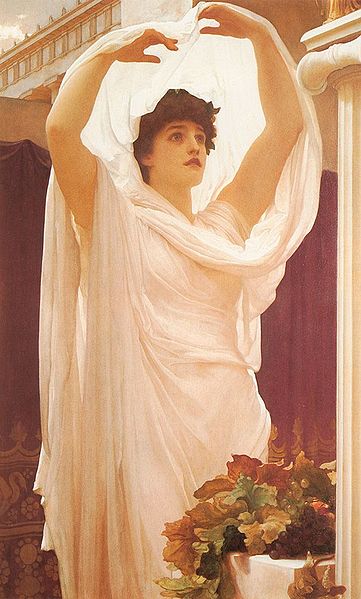
by Andrew Morse | Mar 24, 2011 | All Articles, Archetypal Characters, Guest Contributors |

Emily Dickinson Image via Wikipedia
In his biography of Emily Dickinson, Alfred Habeggar describes a scene where Emily sits happily in the lap of a male acquaintance in the front room of her family home. During her later years, she found pleasure in this man’s attentions long after mysteriously absenting herself from Amhearst’s social life and an almost complete inaccessibility to all but the most intimate and trusted friends and family. We know her to be an eccentric and quite likely a virgin, yet this example contradicts all that we assume about virgins. How can someone who rejects physical intimacy and normal human sexuality be comfortable canoodling with a widowed judge? As well, there are many accounts of Queen Elizabeth I being overly demonstrative and affectionate with male courtiers and visiting dignitaries while also cultivating a reputation as the Virgin Queen. Notes written in the private papers of her Council members and others close to her affirm their belief in her sexual inexperience. The question bears repeating: How can a virgin be at once physically inaccessible and sexually expressive?
Typically, a virgin is seen as one who cannot bear to be touched, inexperience, naive, and traditionally female. These barriers to intimacy comprise an over-identification of the self with intangibles in an inviolable sense of purity, or the Damaged Virgin. We see similar expressions in ourselves when we recoil from an object that is unclean, like scrubbing a toilet on our hands and knees or laying flat on our backs to change the oil in a car. Our wider culture has limited the state of the Virgin to the purity and separateness of her body, specifically the state of her hymen. “Virgin” is often used in reference to an individual’s state of pre-initation before a particular experience (a vessel’s first trip is a “maiden voyage”). This usage refers to a lack of experience in an individual or object, implying a transitional consciousness, a Before and After expression when looking back tat the event.
Unfortunately for the damaged virgin, very few people on this planet have arrived without the benefit of at least one person having an orgasm. Sexuality and physical intimacy is an experience that all of us share in common, both in our own experiences and that of our forebears. For some, engaging in a mutual sexual experience is the basis for expectation and ownership. As the comedian Sommore says in The Queens of Comedy, “…you f*ck with me, you stuck with me.” [Censorship added] For much of human history, the act of marriage has transferred the exercise of a woman’s power of choice from her father to her husband,

Vestal Virgin engraving by Sir Edward Leighton
demonstrated most visibly in the change of her name. But in ancient Rome, when a girl was selected to enter the service of the Goddess Vesta, she escaped the common social practice of her culture and moved beyond the strict bondage of a male relative. She was expected to remain celibate, (to be more specific, uninitiated in the ways of physical intimacy with a man) in her 30 years or more in Vesta’s service. Serving the goddess effectively and exemplifying an unimpeachable character for Rome’s citizens required a great degree of training (education), consequentially enabling a personal mind, her own view of herself and the world. Whether she decided at the end of her term to remain within the Temple or to go out into the world and marry a man of her choice, in her late-thirties on, neither the Vestals’ mind nor body would be owned by husband, father, son or brother.
We can examine a virgin’s sexuality as a means of seeing this pattern symbolically: Sexuality is a way of expressing a person’s accessibility . Literally, a virgin’s crotch is closed for business. We can say ‘access’ is also ‘proximity’ in that we often do not allow ourselves to be near certain experiences, ideas, and individuals. When we hold ourselves apart from the truth, when we won’t allow certain people near us for whatever reason though simultaneously we long to be with them, we are expressing a damaged virginity.
The Virgin’s association with purity applies deeper than a physical condition and contacts an inherently internal intimacy. This archetype enters our lives when we feel a need to draw inward, pursuing exquisitely personal questions that are commonly suppressed in the social expressions of ourselves. In the doldrums of personal awareness we may not access others in the same ways we had before, lacking connection professionally, socially, sexually, and conversationally that were once so automatic and assured. The Virgin can be seen as a gatekeeper of the spiritual path, an advocate for personal introduction. But the expression of the Virgin as a spiritual mentor is temporary and wisely recognized as a pause for the sake of upgrading ourselves. Once our lives open up again, we return in possession not only of new understandings, but of ourselves too.
More than a sexual experience with a cast of one (or for some of us, hundreds), this archetype contacts an outrageous expression of one’s personal identity. “Outrageous” because this pattern has the potential to embody an inviolability that is independent of our experiences, lays beyond our physical location, is separate from our familial lineages. Virgins contain a knowledge of themselves that can be seen by others, but never tainted, claimed, co-opted, or violated. Going through the experience of isolation and self-focus earns the Virgin attributes that extend beyond any physical grasp.
One answer to the question how can a virgin be at once physically inaccessible and sexually expressive may be:
I am myself. My body, my attention, my affections are all mine to share and intimacy at any level comes from me, not as a reward or certificate of ownership, but as part of that which I have to offer those of my choosing.
References
Mythology/Religion: Artemis/Diana; The Madonna; Hestia/Vesta; Minerva/Athena; Vestal Virgins
Historical Figures: Queen Elizabeth I; Emily Dickinson; Joan of Arc
Movies: The Forty Year Old Virgin; Sean Connery in The Medicine Man; Kirstin Dunst et al. in The Virgin Suicides; Jennifer Jason Leigh in Fast Times at Ridgemont High
Andrew lives in Portland. When he’s not concocting original condiments, knitting, and reading, he occasionally finds himself writing poetry and archetypal articles. You can email him directly: heartbreakthrough@gmail.com Photo by: Anatoly Petrenko
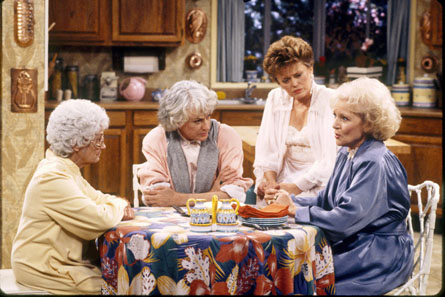
by Andrew Morse | Feb 22, 2011 | All Articles, Archetypal Characters, Guest Contributors, In search of wisdom blog, Pop Culture Archetypes, The Core Archetypes |
Understanding archetypes goes much deeper than a chat about a movie and beyond the confines of a psychology textbook. An archetype is not just a pattern “out there” in theory but it is a recurring set of experiences that unfold through the course of a human life. Our ability to spot when a particular pattern walks in the door makes the difference between acting out and making a conscious choice. We begin to view the shape of our lives within an archetypal language by introducing ourselves to four patterns that we all share, the Survival Archetypes. Let’s imagine that four well-known television characters become clothed for a time with each her own version of a pattern. Rose, Blanche, Dorothy and Sophia share a home somewhere in Miami in the Emmy winning television sitcom, The Golden Girls.
The Child

‘Rose’ image via Wikipedia
This pattern and the next are the most obvious to match with characters from the show. Rose captures the essence of the Child perfectly. Her wide, gullible eyes lack any indication of doubt because she accepts anything an adult tells her. The pattern itself balances innocence and responsibility. Forced to make her way through life by her own efforts, Rose gathers herself up from a fantasy world where she is taken care of by her husband’s pension plan or a steady job and takes life on directly. This is significant because the Child has to leave the safety of the family and enter a harsh world populated by sharply critical adults. When we want to run away from a situation and deny what is happening, we are confronting the Child within us. Yet this is also the pattern where we can choose to see each situation as overflowing with limitless potential and see things as new again.
The Prostitute

‘Blanche’ image via Wikipedia
Of course it’s Blanche. In almost every episode, she decides to assign a value to her body by comparing her looks to another woman or using her body to advance her own interests. At every turn Blanche is chasing a man or furious that her wiles haven’t produced the results she expected. The Prostitute grabs a price scanner and makes its mark on every part of us it can so that we feel safe in the world, often by remaining in a relationship or a job. Whenever she is confronted with a problem, Blanche throws on a negligee and adjusts her makeup in order to barter her way through. She never fully believes in her own capacity to solve her problems beyond her salable attributes. Only by the end of an episode does Blanche find what is truly valuable: Her friendships and sense of herself beyond her outward appearance.
The Victim

‘Dorothy’ image via Wikipedia
Dorothy is the “smart” one with the cold stares and the newspaper in her hand, ever expounding on the failures of society with its potential to violate and betray us. It is her voice that speaks up after silently burning for a few moments, waiting for the assault to stop, and sets appropriate boundaries. More than a few times Dorothy picks up a newspaper and hits Rose over the head when the St. Olaf stories go on too long. This is the Victim, present when we feel unable to defend ourselves but also when we go after someone else for revenge. Its empowerment isn’t in aggression and dominance but in being clear about our boundaries as they relate to who gets “in” as well as how far you get “out.”
The Saboteur

‘Sophia’ image via Wikipedia
Sophia’s entrance is often preceded by someone starting to dream about a wonderful new idea or vision of themselves. She shuts them down with a opinion based on how they will fail, often gouging out a chunk of self esteem in the process. The Saboteur does the same. Dorothy, for her part the empowered Victim, slaps her hand across Sophia’s mouth to prevent the impending criticism. When you are about to make a choice that will interrupt a new opportunity for you to build self-esteem and connect to your destiny, the Saboteur has entered the room. Through the entire series, Sophia exemplifies the Saboteur in her attempts to pursue a vibrant, active life for a woman in her eighties and confronts the view that she is hastening towards senility and the grave. The ability to step into a new life for ourselves is guarded by the Saboteur, but make no mistake: This is the pattern where WE are blocking our way forward, not anybody else.
Blanche: What do you think of my new dress? Is it me?
Sophia: It’s too tight, it’s too short and shows too much cleavage for a woman your age.
Dorothy: Yes, Blanche. It’s you.
 Picture it: One night you can’t get to sleep. Something’s really bothering you at work or you’re ashamed of your bank account. Maybe you’re not with the person you love anymore. Whatever it is, you get up and shuffle into the kitchen. Soon, you are surrounded by four of your lifelong archetypal pals, only they’re doing all the talking. You sit there on the table while they pick at you, bicker and lay into each other with their concerns and fears. Basically, you’re a cheesecake, slowly eaten away bite after bite. Instead of becoming a pile of crumbs when these voices are in control, we can take the time to pursue a relationship with them. We can know when we are making a choice that obscures or magnifies our destiny. At first a silent partner, studying our deeper motivations, but in time we claim our place at the table. Eventually, we will distance ourselves from their automatic choices and see what has been waiting beyond our fears in front of us the whole time.
Picture it: One night you can’t get to sleep. Something’s really bothering you at work or you’re ashamed of your bank account. Maybe you’re not with the person you love anymore. Whatever it is, you get up and shuffle into the kitchen. Soon, you are surrounded by four of your lifelong archetypal pals, only they’re doing all the talking. You sit there on the table while they pick at you, bicker and lay into each other with their concerns and fears. Basically, you’re a cheesecake, slowly eaten away bite after bite. Instead of becoming a pile of crumbs when these voices are in control, we can take the time to pursue a relationship with them. We can know when we are making a choice that obscures or magnifies our destiny. At first a silent partner, studying our deeper motivations, but in time we claim our place at the table. Eventually, we will distance ourselves from their automatic choices and see what has been waiting beyond our fears in front of us the whole time.
More articles about the Survival Archetypes
Andrew lives in Portland. When he’s not concocting original condiments, knitting, and reading, he occasionally finds himself writing poetry and archetypal articles. You can email him directly: heartbreakthrough@gmail.com Photo by: Anatoly Petrenko
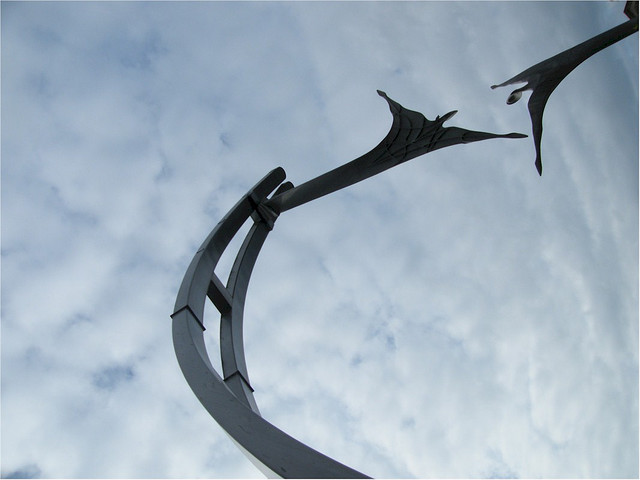
by Julienne Givot | Oct 25, 2010 | All Articles, Archetypal Characters, In search of wisdom blog, Real Life Archetypes |

Image via Wikipedia
I try to make a point to write about what could be called the ‘unsung’ archetypes. One’s that don’t seem to have a popular or even a very present place in our culture. Last month I wrote about the archetype of the Scribe to illuminate it’s presence and potential for positive change.
I’ve recently come across some wonderful pieces of poetry and it brought to mind the power of the Poet archetype. For many people poetry can seem lofty , arcane or just downright fluffy in terms of day to day life and yet a good piece of poetry can stop us in our tracks with it’s ability to communicate a deep truth. T.S. Eliot I think puts it best.
“Genuine poetry can communicate before it is understood.” ~T.S. Eliot
When I come upon genuine poetry as Eliot describes, I am taken aback by its ability to circumvent the mind and drop away all it’s judgment so I can just be with something true.
My recent discovery is that of the contemporary Poet, David Whyte. He embodies the Poet archetype as well as the Teacher, the Philosopher and the Guide. He is not only a respected Poet but also teaches corporate executives and businesses using poetry as well as being the author of several non-fiction books. In reading his work I felt first-hand, the power of the Poet – the transmission of a truth with a capital ‘T’.
Start close in,
don’t take the second step
or the third,
start with the first
thing
close in,
the step you don’t want to take.
(Excerpted from “Start Close In” – the full poem can be found here.)
In trying to sum up the deepest power of the Poet archetype, I found exactly what I was looking for in the description of one of Whyte’s workshops:
Poetry as Robust Vulnerability: Language Against Which We Have No Defenses: Poetry is a break for freedom. The discipline of poetry is in overhearing yourself say difficult truths from which it is impossible to retreat. In a sense, all poems are good; all poems are an emblem of courage and the attempt to say the unsayable. Yet only a few are able to speak to something universal yet personal and distinct at the same time; to create a door through which others can walk, into territory that previously seemed unobtainable, in the passage of a few short lines.
Now that is a power worth treasuring! I’ll agree with Shelley when he said that Poets are the unacknowledged legislators of the world.
References
Films: Glenda Jackson in Stevie; Philippe Noiret in Il Postino; Sean Connery in A Fine Madness, Leonardo DiCaprio in The Basketball Diaries; Wes Bentley in American Beauty, Ethan Hawke in Dead Poets Society; Janet Jackson and Tupac Shakur in Poetic Justice
Fiction: The Basketball Diaries by Jim Carroll (shadow);
Religion/Myth: King David (ruler of Israel credited with writing many of the Psalms); Orpheus (great musician and poet of Greek myth, capable of charming wild beasts); Bragi (in Norse myth, the god of eloquence and patron of poets); Finn Mac Cumhail (legendary Irish hero and leader who was also greatly skilled as a poet).
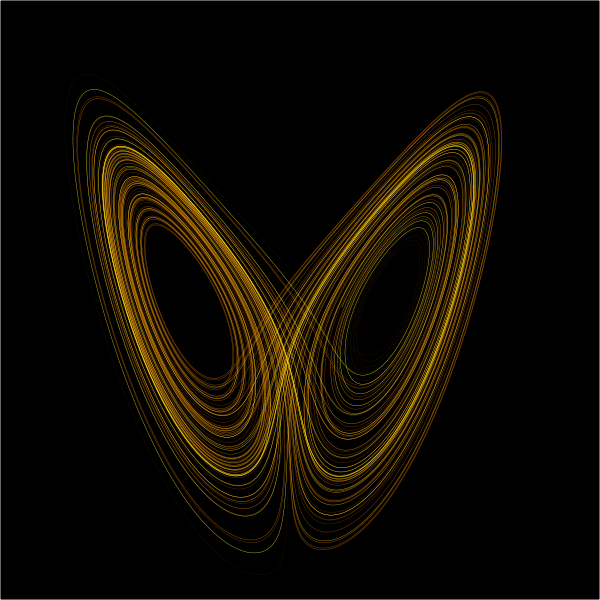
by Julienne Givot | Aug 24, 2010 | All Articles, In search of wisdom blog |

Lorenz attractor
The ingredients for a resilient, empowered and purposeful life are within you. That knowledge is at the heart of my practice and my vocation is to provide the tools and guidance to not only learn more about the wonderful person that is you, but to live more fully by discovering your own powerful resources.
Nearly every client I speak with and those I meet when I’m out and about, all share a feeling that they are being called to live their lives more fully and use their resources for something greater than before.
It’s no wonder that we are feeling this way. We see the word ‘chaos’ being used so often across all forms of communication to describe our world’s condition. The word ‘chaos’ is Latin for ‘void’ although it gets used more often to mean ‘unpredictable’. The idea of a void can often seem frightening – that anything can happen. To quote Holly Golightly in Breakfast at Tiffany’s, “Anything can happen, and quite frequently does.” That, I believe is the grace in chaos, unprecedented activity of change opens immense doors of opportunity. Those who are able to embrace that change will excel in these chaotic times.
People from all walks of life are being called to learn more deeply about themselves using whatever means – music, art, gardening, academia, spiritual studies, myths and of course archetypes. Some people decide to put off their learning because they say their life is too chaotic and that they will look into it again when things have calmed down. There is the notion that self-knowledge is something extra and not necessary to work with our changing times. It’s really quite the opposite! Every chaotic action or unexpected change is a call to look more deeply into ourselves for the power to proceed and above all, to be creative. The more you know of yourself and what incredible things that you are capable of, the more resilient you will be when changes happen. The more you uncover your own unique strength and beauty, the more you will tread on purposeful ground, be it at the grocery store buying food, in a meeting at work or deciding what to do next.
by Julienne Givot | Aug 3, 2010 | All Articles, Pop Culture Archetypes |
I often use movie and television references in my consultations. They are one of the best ways to really see archetypal patterns  in action. We all have an instinctual sense of archetypes and can usually spot them pretty quickly – especially when they are on screen.
in action. We all have an instinctual sense of archetypes and can usually spot them pretty quickly – especially when they are on screen.
To make my point, a few months ago I set up a handful of polls asking readers to cast actors into roles based on archetypes. I had a feeling that the majority of respondents were going to choose the most appropriate actor for the archetypal role. If I was wrong, then I lose the bet with one of my clients and I would have had roasted wool hat for dinner. Not to gloat, but I was right! All of the actors that I felt were far and above the best choice for the role based on their archetypal range were cast also by over 200 readers over a three month period. Some of you wanted to know what my client had to do should he lose the bet and well, I think it’s fair to say that I am now in possession of a very nice bottle of wine from his collection.
The results from the Archetypal Casting, chosen by readers with over 200 votes May 2010-July 2010:
Who you cast as the Damsel in distress?
Kirsten Dunst 72%
Lucy Liu 16%
Uma Thurman 13%
Who would you cast as the Court Jester (Fool)?
Will Ferrell 97%
Liam Neeson 3%
Daniel Craig 0%
Who would you cast as the King?
Sean Connery 91%
Kevin Costner 6%
Robin Williams 3%
Who would you cast in the role of the Evil Wizard?
Gary Oldman 91%
Tom Hanks 6%
Will Smith 3%
Who would you cast as Athena, the Goddess of Wisdom?
Julianne Moore 83%
Lisa Kudrow 11%
Sarah Jessica Parker 6%
Who would you cast as the Femme Fatale?
Angelina Jolie 95%
Meg Ryan 3%
Resse Whiterspoon 3%

by Julienne Givot | Apr 22, 2010 | All Articles, In search of wisdom blog |
Reunion: How We Heal Our Broken Connection to the Earth 
by Ellen Gunter and Ted Carter.
This is an incredible and practical guide to reconnecting with our planet co-authored by one of my colleagues from the CMED Institute.
Highly recommended!
Click here to purchase
editorial description: From the earliest mythologies, it’s clear we all start as a little bit of dirt. But these stories aren’t just entertaining. They also carry a profound message: each of us is born with a deep and abiding connection to the earth, one that many of us have lost touch with. The authors, Ellen Gunter and Ted Carter, spent more than two years interviewing organic and biodynamic farmers, environmentalists, filmmakers, authors, farming advocates, teachers, and spiritual leaders to understand how that connection is present in our lives-and how we can begin to see it ourselves. Using historical narratives, dozens of simple and profound practices and examples of people whose adventures in earth stewardship are showing us the way to our own roles in the world’s environmental crises, REUNION: HOW WE HEAL OUR CONNECTION TO THE EARTH is about how we rediscover and repair that connection ourselves-and by doing that, open ourselves up to solutions we had never considered before.

 Podcast available on Apple Podcast, iTunes and pretty much wherever you download your podcasts.
Podcast available on Apple Podcast, iTunes and pretty much wherever you download your podcasts.




 nto each life comes information that changes the course of your life, in tiny ways and gargantuan ones. For me, books have always been a source of life-changing information. Fiction and non-fiction alike have turned the rudder of my life for as far back as I can remember. There are some that I sought out, heard about from a friend or teacher and others that literally have leaped off the shelf and fallen at my feet.
nto each life comes information that changes the course of your life, in tiny ways and gargantuan ones. For me, books have always been a source of life-changing information. Fiction and non-fiction alike have turned the rudder of my life for as far back as I can remember. There are some that I sought out, heard about from a friend or teacher and others that literally have leaped off the shelf and fallen at my feet.


 that only remote regions can give. Card number 9 allows our hero traveling through the Major Arcana to either meet or become this humbled figure full of in-sight, as represented by his seeking lantern. A re-evaluation of his journey is required after a run-in with the objectivity of Justice, before he can once again chance the Wheel of Fortune (Card number 10). Consideration of this card allows us all a moment to reflect without being sucked into eternal isolation – the shadow side of the Hermit. Fresh from a (hot) visit from her hometown of Joshua Tree, California, Cyndera shares fresh inspiration after encountering an old friend who embodies the Hermit archetype. Julienne takes us on a tour of the hermitic nature of the American literary Renaissance along with some insights on the Hermit from film and popular culture.
that only remote regions can give. Card number 9 allows our hero traveling through the Major Arcana to either meet or become this humbled figure full of in-sight, as represented by his seeking lantern. A re-evaluation of his journey is required after a run-in with the objectivity of Justice, before he can once again chance the Wheel of Fortune (Card number 10). Consideration of this card allows us all a moment to reflect without being sucked into eternal isolation – the shadow side of the Hermit. Fresh from a (hot) visit from her hometown of Joshua Tree, California, Cyndera shares fresh inspiration after encountering an old friend who embodies the Hermit archetype. Julienne takes us on a tour of the hermitic nature of the American literary Renaissance along with some insights on the Hermit from film and popular culture. I also found it amusingly appropriate that Led Zeppelin used the image of the Hermit for their single ‘Stairway To Heaven’ which carries lyrics capturing the ideas of the Hermit’s quest.
I also found it amusingly appropriate that Led Zeppelin used the image of the Hermit for their single ‘Stairway To Heaven’ which carries lyrics capturing the ideas of the Hermit’s quest.
 what’s going on, but paying attention to these powerful patterns can really improve your dating experience. I mean, wouldn’t you want something to help guide you through the sometimes dark and murky forest of dating life and toward what you are really looking for?
what’s going on, but paying attention to these powerful patterns can really improve your dating experience. I mean, wouldn’t you want something to help guide you through the sometimes dark and murky forest of dating life and toward what you are really looking for?


 We are in an age of connectivity and it doesn’t appear that we can ever really go back to a time of slow paced communications. It’s as if technology is making Networkers of all of us to one degree or another.
We are in an age of connectivity and it doesn’t appear that we can ever really go back to a time of slow paced communications. It’s as if technology is making Networkers of all of us to one degree or another.








 Picture it: One night you can’t get to sleep. Something’s really bothering you at work or you’re ashamed of your bank account. Maybe you’re not with the person you love anymore. Whatever it is, you get up and shuffle into the kitchen. Soon, you are surrounded by four of your lifelong archetypal pals, only they’re doing all the talking. You sit there on the table while they pick at you, bicker and lay into each other with their concerns and fears. Basically, you’re a cheesecake, slowly eaten away bite after bite. Instead of becoming a pile of crumbs when these voices are in control, we can take the time to pursue a relationship with them. We can know when we are making a choice that obscures or magnifies our destiny. At first a silent partner, studying our deeper motivations, but in time we claim our place at the table. Eventually, we will distance ourselves from their automatic choices and see what has been waiting beyond our fears in front of us the whole time.
Picture it: One night you can’t get to sleep. Something’s really bothering you at work or you’re ashamed of your bank account. Maybe you’re not with the person you love anymore. Whatever it is, you get up and shuffle into the kitchen. Soon, you are surrounded by four of your lifelong archetypal pals, only they’re doing all the talking. You sit there on the table while they pick at you, bicker and lay into each other with their concerns and fears. Basically, you’re a cheesecake, slowly eaten away bite after bite. Instead of becoming a pile of crumbs when these voices are in control, we can take the time to pursue a relationship with them. We can know when we are making a choice that obscures or magnifies our destiny. At first a silent partner, studying our deeper motivations, but in time we claim our place at the table. Eventually, we will distance ourselves from their automatic choices and see what has been waiting beyond our fears in front of us the whole time.





